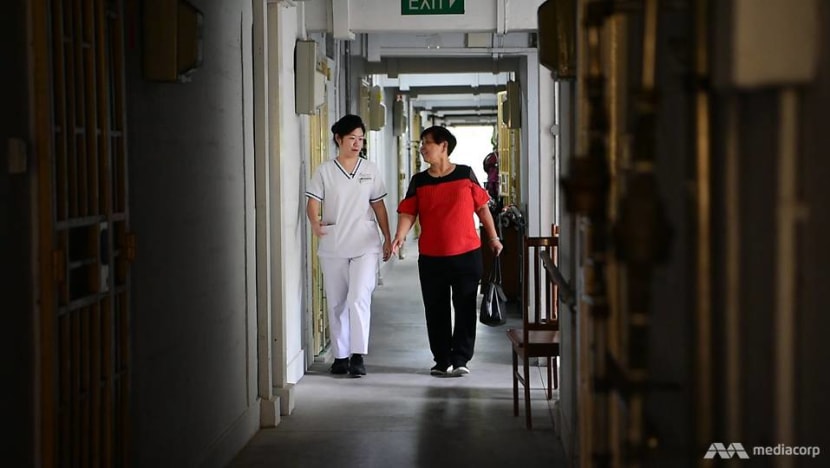‘We can tell them life is still worth living’: The community nurse who helps keep the elderly out of hospital
For Chinatown’s chronically-ill seniors, nurses like 27-year-old Chua Yu Ru - who make their rounds not in a hospital but in HDB blocks – are making the difference between pain and declining health, and a better-managed life.
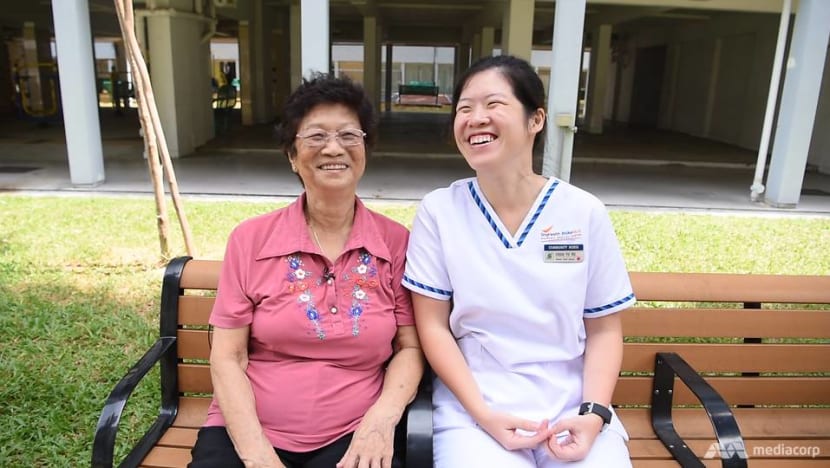
Community nurse Chua Yu Ru, 27, helped Mdm Kek Eh Nau, 79, find some respite from caring for her husband with dementia.
SINGAPORE: The floor of Mr Hoh Ah Kaw’s one-room flat was sticky, and there was a lingering dampness in the air.
His bed sat awkwardly two feet from the door, clothes hanging from a pole above it, but amid the cramped clutter of old furniture, what caught Ms Chua Yu Ru’s eye were boxes and boxes of eye-drops sitting atop a dresser. They were all unopened.
It took a while before the frail 79-year-old finally admitted to her that he had no one to help him apply the eyedrops to his cataract-ridden eyes.
“He told me his hand had no strength to press the bottle,” said Yu Ru, a 27-year-old senior staff nurse. So for months, he had simply resigned himself to skipping the four daily applications that the doctor had prescribed.
It is residents like him who spur Yu Ru to spend her days pounding the ground on her daily rounds as a community nurse in Chinatown, looking out for the ailing elderly residents – many of whom live in rental flats – and doing her best to help keep them out of hospital.
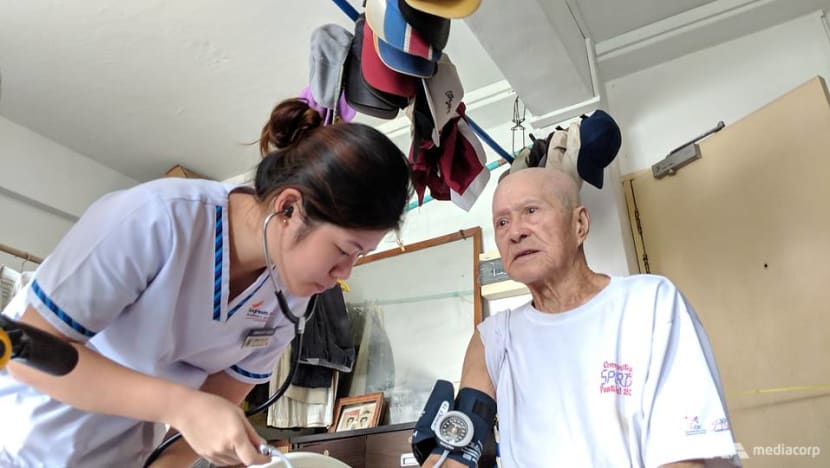
Suffering from assorted chronic conditions, from diabetes and hypertension to congestive heart failure, many are fatalistic about the situation, and tend to neglect doctors’ orders, their medication, or even seeking help.
“Many times, due to not being sure who to approach or where to seek help, the residents do not get the treatment that they need - or they are not even aware they have certain conditions,” she said.
Some of the elderly think that just because they are old and sick, life is just like that.
"But we can be the voice telling them that life is still worth living, and help them change the way they approach their health," she added.
In Mr Hoh’s case, Yu Ru helped him obtain an eyedrops applicator that lets him apply the medication with an easy push of a button. Once a week, she visits to check that he has been doing it right.
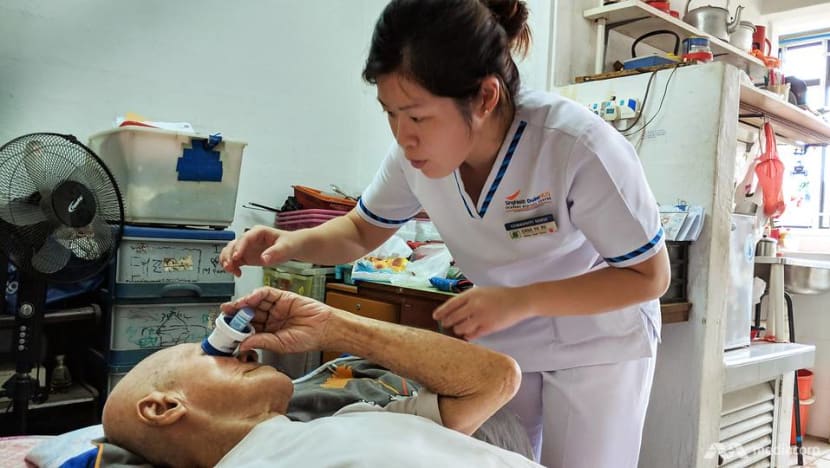
As the population ages, more nurses like her are being stationed within neighbourhoods across Singapore. Yu Ru works out of two community nursing posts in Chinatown – one at Banda Street and another at Jalan Kukoh – set up by the Singapore General Hospital (SGH).
Though these posts, located at Senior Activity Centres, are set up for standard checks like blood-pressure readings, it quickly becomes clear that the heart of these nurses’ work goes beyond the clinical.
As CNA Insider trailed Yu Ru on her rounds, she stopped many times to greet eager residents. Like the elderly uncle who, from two floors above, spotted her familiar white uniform and trolley bag of medical supplies, and waved excitedly.
“Come visit me soon!” she called back to him.
“Have you eaten?” she asked another resident in Hokkien. “Kopi ga dai” – coffee with more condensed milk, he told her.
“Ga dai?!” Yu Ru exclaimed in mock disbelief, making a mental note to watch for signs of diabetes at his next check-up at the nursing post.
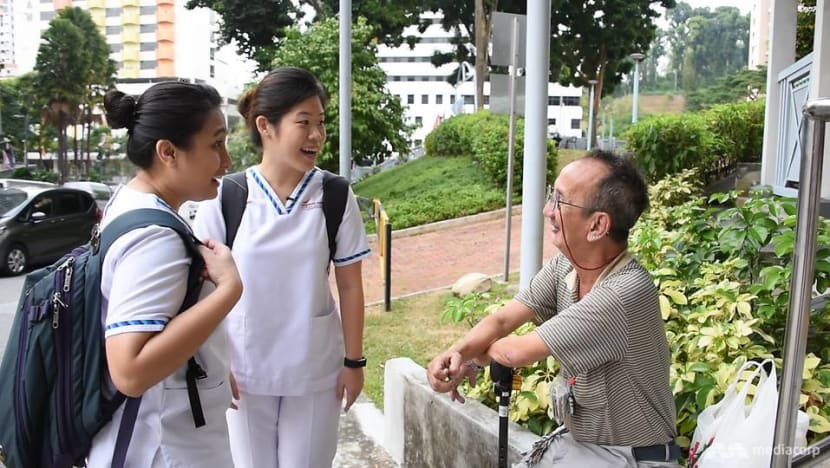
It’s these relationships they spend time building that makes the elderly residents more likely to listen to the nurses’ advice, and to trust them with deeply personal matters.
Said Yu Ru: “They don’t just see me as a nurse. They see me as family. And I think it comes from seeing that we are genuinely here to help them for the long term.”
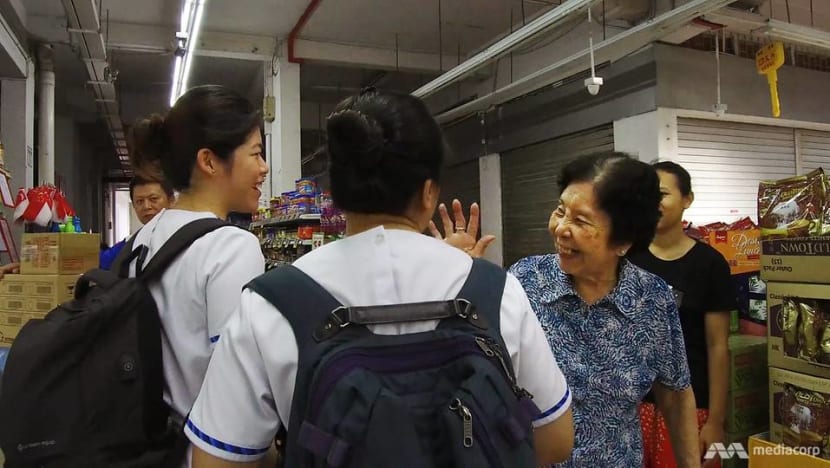
WHY COMMUNITY NURSING?
Prior to becoming a community nurse last year, Yu Ru worked in SGH’s general surgery ward for four years.
The work was by nature fast-paced – wound dressing, serving medication, discharging patients. In most cases, she saw the patient just once. So it was those who kept coming back that made Yu Ru stop to think.
They were diabetic patients, vulnerable to infections in the lower limbs, and requiring amputation when wounds went unchecked. One would come in for a toe amputation, and Yu Ru would do her due diligence to teach the patient how to take care of their wound at home.
But a few months later, the same patient would be back for a forefoot amputation. And later on, below-knee amputation.
Seeing such patients broke her heart, she said. “I felt that what I was doing as a surgical nurse seemed limited at that point in time.”
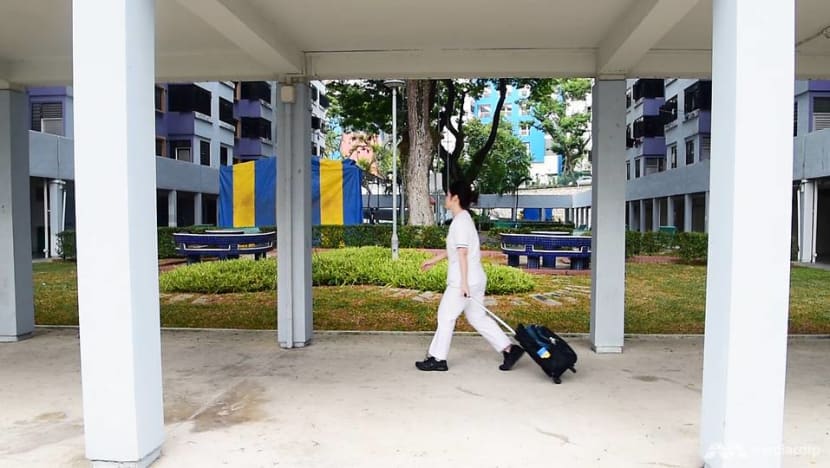
In 2016, inspiration came when Yu Ru joined a medical mission trip to rural Papua New Guinea, where access to healthcare was limited and her team brought medical services to the remote villages instead.
It made her wonder. “Rather than being at this end of the spectrum where I’m just fighting fires and preventing further complications, could I go to the other end where I teach (patients) about diabetes or how to value their health?”
She took up an Advanced Diploma in Nursing, specialising in chronic disease management. And when she completed her studies in 2018, SGH was fortuitously setting up community nursing posts as part of the Ministry of Health’s nationwide plan to bring healthcare closer to home.
Yu Ru grabbed at the opportunity for a transfer. “It was what I really wanted, and I never expected it to happen in such a timely manner,” she said.

Across Singapore, there are now 70 nursing posts set up by various hospitals, 23 of which are run by SGH. Yu Ru was posted, along with five other nurses, to kickstart Chinatown’s two nursing posts.
A year on, the two posts are among SGH’s busiest. The one at Jalan Kukoh, for instance, sees about 110 residents a month.
INTERVENING EARLY
When Yu Ru is not at the post, she’s making as many as six home visits in a day in the Outram catchment area, which comprises China Square, Chinatown, Pearl’s Hill and People’s Park.
These visits often help Yu Ru spot environmental factors that affect a resident’s health, or detect symptoms of illnesses early, which she says is the “biggest benefit of community nursing”.
WATCH: What a community nurse does (8:17)
One of her regular visits is to 69-year-old Abas Mawas, who has diabetes and end-stage kidney failure.
When Yu Ru first met Abas – whom she affectionately calls “Datuk” (grandfather in Malay) – he had an open wound on his big toe that needed regular dressing.
But what was a minor injury became a major infection, and the toe turned gangrenous.
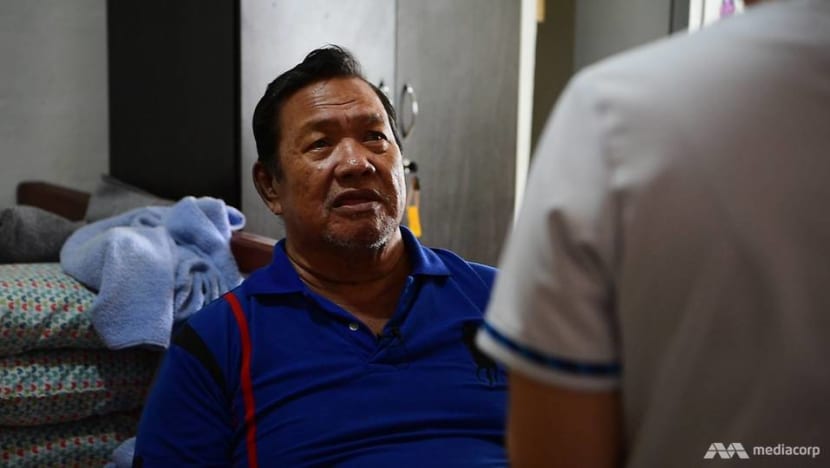
These warning signs were all too familiar to Yu Ru, and she pleaded with Datuk to check himself into the hospital immediately. If he amputated his toe on time, it could stop there; otherwise, the infection could spread in his bloodstream and his entire foot might have to go.
Datuk, however, badly wanted to attend a family member’s wake, and would not be convinced.
“At that point in time, I had to respect his decision,” Yu Ru said. “I’d rather he knew that I was there for him whenever he was ready to go to the hospital.”
Indeed, within a few hours, Datuk changed his mind and called her, and she rushed over from another home visit to arrange for an ambulance.
For that, Datuk is forever thankful. “If she didn’t save me, maybe this foot also would be no more,” he said.
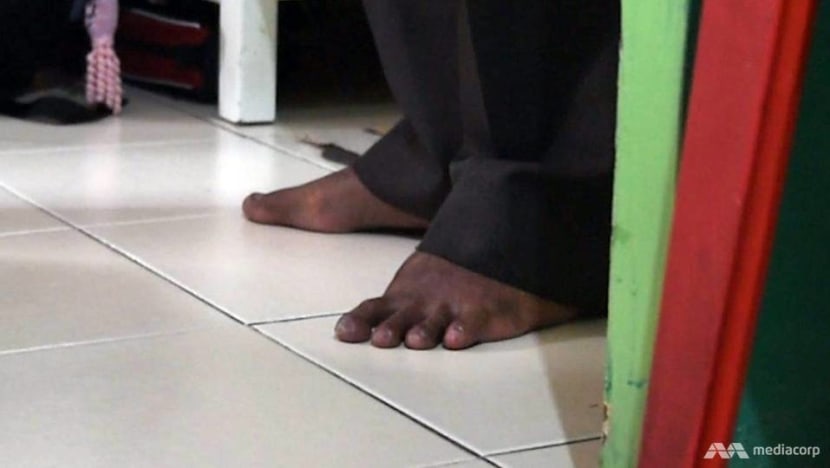
THE COMPLEX TAO OF RELATIONSHIPS
Chatting with residents in Hokkien, Cantonese and a bit of Malay, Yu Ru is “kaypoh” in asking about their social lives, how many children they have, so on – as these factors can contribute to their state of health.
Many look forward to her visits; living alone, hardly visited by family if at all, their spirits get a lift from the companionship and smiles that she brings.
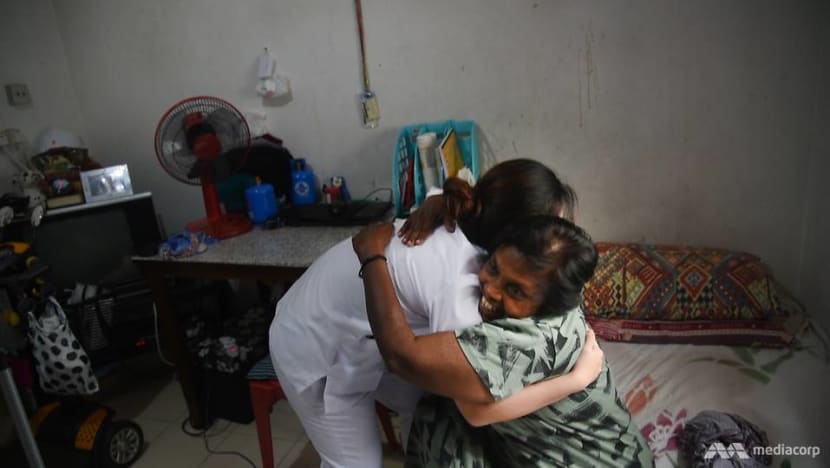
But forging relationships has been a more complex undertaking than Yu Ru had imagined – especially in her early days as a community nurse.
“At first, I thought most people would be excited that there was fully-subsidised healthcare brought right to their doorstep,” she said.
But when her team went knocking on doors to introduce the slew of new healthcare services available, some were not interested. They would say they did not need doctors, or that they only used traditional Chinese medicine.
This was a jarring experience for the nurses. “In the hospital, they come to you to seek treatment. Over here, we have to coax them to come for check-ups.”
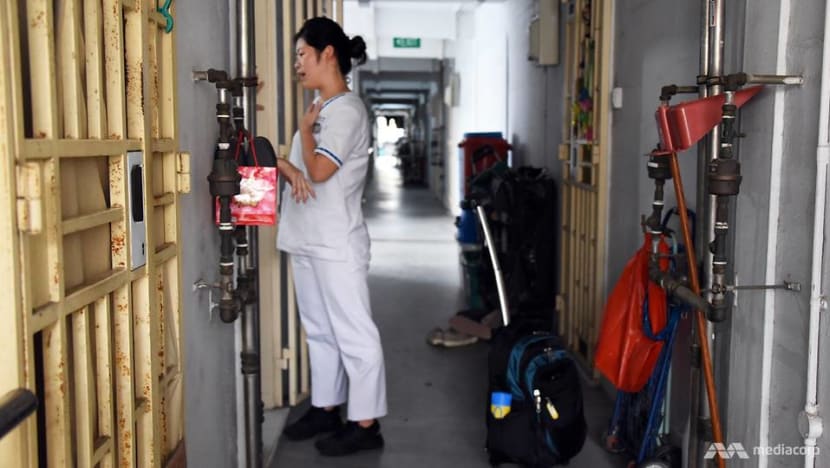
And even when the nurses won the residents over, the relationship might still hang by a thread – something Yu Ru “learned the hard way”.
One of her first few cases was a man with poorly controlled diabetes. He agreed to let Yu Ru check his blood sugar levels every day, as requested by his doctor.
During these check-ups, Yu Ru would often ask what he had eaten, and his responses were always about noodles and kueh, precisely the food he should avoid. Yu Ru suspects it was her negativity that eventually drove him away.
“He would always hear me say not good, not good, not good,” she said. So after two months, he stopped coming altogether. “He decided for himself that eating well is much more important.”
While it was demoralising at first, Yu Ru did not let herself become jaded. Since then, she has learnt the need to “pace (herself) with the residents” before she can help them.
“Coming from the ward, I’m so used to being the one who instructs,” she said.
As much as we are eager to provide the best care for them, they may not be open to accepting advice just yet.
A year since she last saw that resident, Yu Ru managed to touch base with him recently. This time, she simply asked about his well-being.
“I’m waiting for that moment where he’s open to us again,” she said.
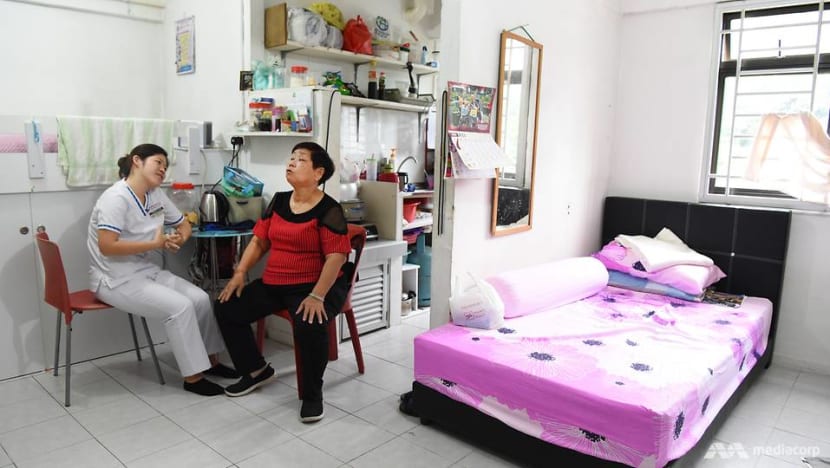
SIMPLE THINGS COUNT
Dr Lee Wan Sian, a family physician at the Outram Polyclinic, lauds the holistic care that community nurses provide “beyond the clinical setting”.
Some of the most helpful ways to ensure that residents stay healthy, for example, is to repack their medication in a way that’s easy for them to access; and to help them organise their paperwork (to avoid misplaced appointment letters that lead to missed check-ups).
“Due to a variety of reasons such as physical decline, memory difficulties, lack of medical awareness, and inadequate social support or finances, it can be challenging for some elderly to manage their health on their own,” Dr Lee said.
When faced with multiple pills to take, various instructions to follow, and in some cases, six months’ worth of supply to handle, the elderly can find it daunting to even begin unpacking the medication they’ve brought home.
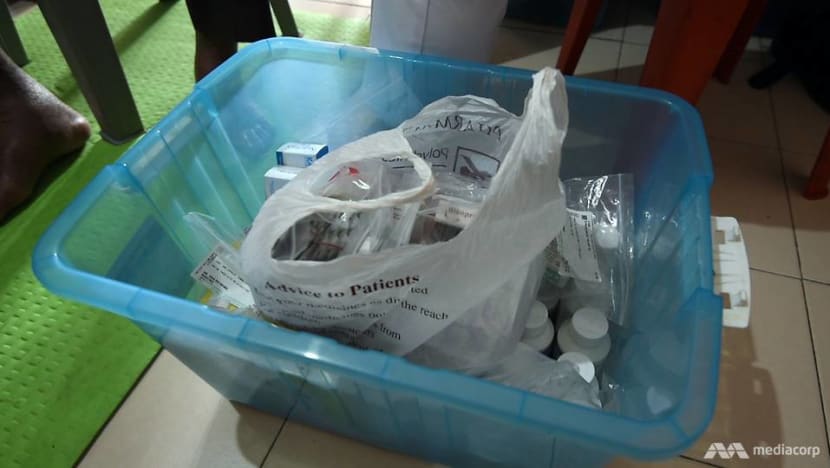
In Datuk’s case, he was given nine types of pills to take at different times of the day – some on different days of the week.
So the first thing Yu Ru did to help was to sort out his medication in labelled pill boxes, and make the instructions easy to follow: A sun symbol for pills to be taken in the day, a moon for night, the numbers 1 to 7 representing Monday to Sunday, which Datuk found easy to follow.
Yu Ru also followed up on subsequent visits to ensure he had taken his medication and re-packed them correctly.
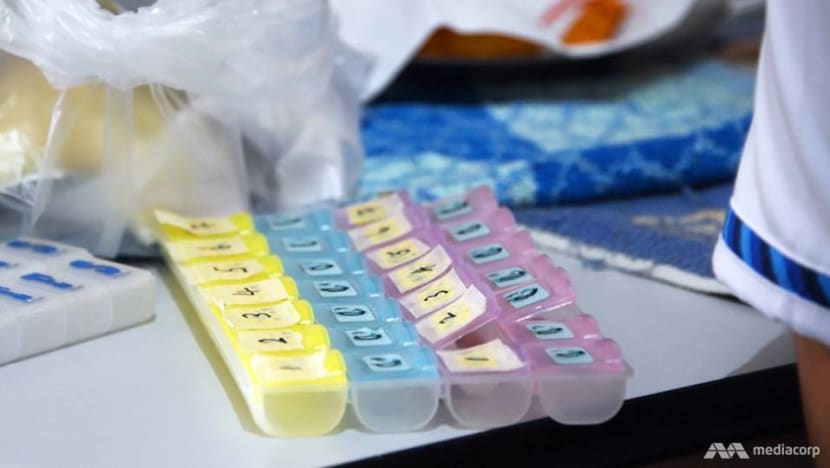
TAPPING OTHER HELPING HANDS
Though Yu Ru and her colleagues may not have the same resources as they did in the hospital - such as being able to tap immediate medical advice from doctors - they can call on community partners to supplement their care for the residents.
One such partner is the Kreta Ayer Seniors Activity Centre.
When a resident doesn’t show up for an appointment, Yu Ru can count on the centre’s volunteers to point her to their usual hangouts – like the time she went looking for one and found him eating his favourite oyster omelette.
In turn, she alerts the centre when a resident needs their services.
On a home visit to Mdm Goh Kung Hong, Yu Ru found out that the 66-year-old had difficulty sleeping due to a bed bug infestation. The thought of bed bugs scared Yu Ru, but she braced herself, took pictures of the traces, and sought help from the centre manager to arrange for fumigation immediately.
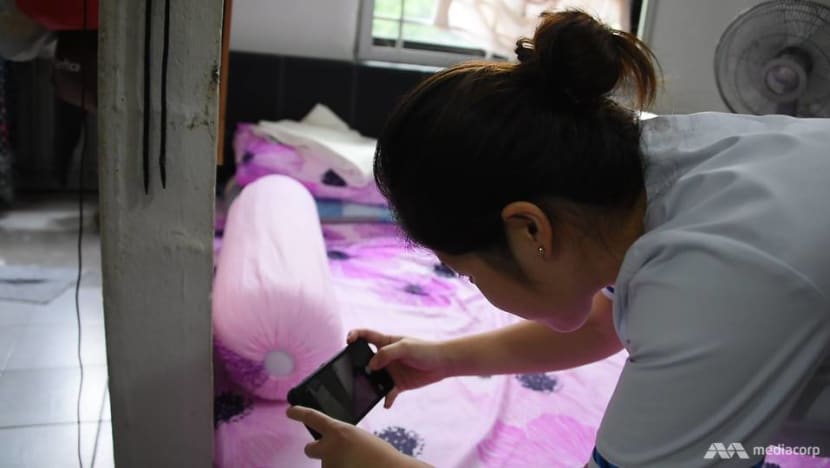
Such things may seem a stretch of a nurse's duty, but she says it’s part of the job. “We not only nurse them, we look at the environment and other factors that might affect their health.”
The community nurses also work closely with Montfort Care, which offers social or emotional support services for the elderly. Both parties refer residents to each other when the need arises.
Take, for instance, Mdm Kek Eh Nau, 79, who looks after her husband who has dementia. Yu Ru noticed this was taking a toll on her.
“It can be quite suffocating to face the husband alone all the time in the house, if she’s not out in the community and engaging with other people,” she said.
So now, every Monday, Wednesday and Friday, Mdm Kek – with her husband and helper in tow – will walk two blocks to Montfort Care’s Fit For Life programme, have a good stretch, and play games with other seniors.
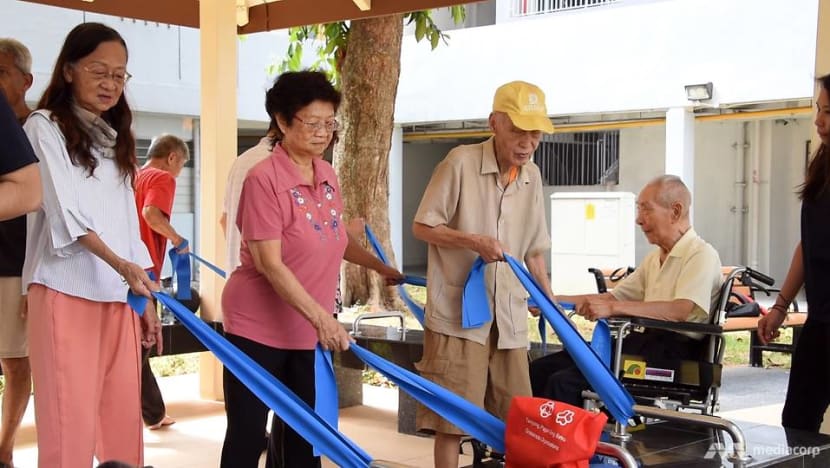
Gary Mok, 37, a case worker who helps to lead the programme, said that having the community nurses means extra pairs of eyes to look out for the elderly residents.
“Since the nurses came, medical care has become more accessible to seniors who are more vulnerable and isolated. We do a lot of joint visits, and a lot of case discussion about the care plan for residents here,” he said.
What Yu Ru appreciates most about her job is the bond she shares with her residents. They evidently adore the sprightly Missy (colloquial term for nurse) – and more than one resident told CNA Insider they saw her as a granddaughter.
Having earned their trust, Yu Ru hopes to change the way the elderly see their health, and empower them to take better care of themselves.
“And I will be there as a friend, a community nurse, to journey alongside them.”
